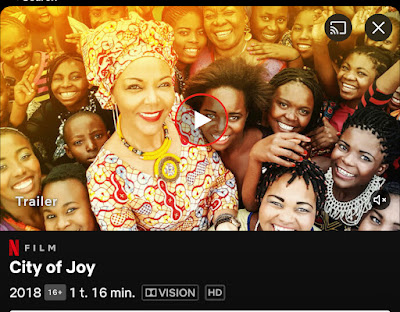"City of joy" midt i krigens gru - jeg anbefaler at se denne film
Alle voksne - også unge voksne (16+) - anbefales at se denne film, som er en unik dokumentar:
Fokus er på City of Joy-projektet i det østlige Congo, hvor kvinder, der har været udsat for grusom voldtægt, genvinder håb og mening med livet.
Dokumentaren er på Netflix, og som noget ganske ekstraordinært er det tilladt, at den bliver vist i undervisningssammenhæng uden særlig afgift.
Introduktion og undervisningsvejledning findes her: CityOfJoy_Film-Guide_2018.pdf
Selvom dokumentaren er hjertevarm og bevægende, kan kvindernes beskrivelser af, hvad de har været igennem, også være traumatiserende for nogle. Det anbefales at læse overvejelserne i undervisningsvejledningen inden brug i undervisning.
Her er nogle citater fra "Director's Statement" på filmens hjemmeside CITY OF JOY: THE FILM - City of Joy
Vold som et middel i krigsførelse
“The eastern part of the Democratic Republic of Congo has endured 20 years of devastating violence. It is estimated that up to 8 million people have been murdered and hundreds of thousands of women have been raped and tortured. Rape has been used as a weapon of war in the conscious destruction of community to get at the precious resources in the area. Congo is often referred to as the worst place in the world to be a woman for all these reasons and more. CITY OF JOY tells another story of that region.
… …”
Kvindernes ærefrygtindgydende ukuelighed
“… But equally arresting was the palpable resilience of these women. My daughter was young at the time, and I was sure that if I had seen her endure what these women had or if my daughter had witnessed such things, I would collapse and my life would be over, period. The fact that these women could find ways to create meaning in their lives after such experiences was awe-inspiring. This is what initially drew me to this story.”
Instruktørens forsøg på at skabe balance mellem beskrivelser af lidelser og håb
“It was important to me that the audience not go numb in the watching of this film, or be so torn up that they shut down and stopped listening. So the balancing between the devastation of what these women had suffered and the incredible force of hope and joy that they embodied was something I grappled with a lot. The shifting tones between pathos, humor, irreverence, and joy were something I strived for, trying to keep the film visceral and surprising in its emotion and arc.”
“
Metoder i brug i skabelsen af dokumentaren
“To this end, I used all sorts of methods and found myself inventing things along the way. I tried to create the feeling of nostalgia, shooting visual elements that represented a past world and the subsequent loss of that world. I worked a lot with sound and music and the interaction of these elements. I saw the war as a sort of character of its own that we revisit throughout the film, learning bits and pieces each time. I tried to give enough history but not too much, and I questioned myself constantly in this regard. This was a real challenge and I hope an audience finds it satisfying but this lacing of elements and tonal shifts was very important to me.”













Comments
Post a Comment